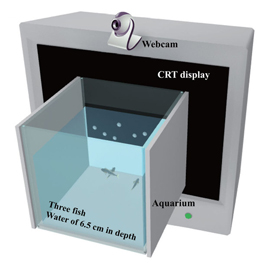Research Abstract
ピンクノイズ運動が捕食行動を誘発する
Visual motion with pink noise induces predation behaviour
2012年1月11日 Scientific Reports 2 : 219 doi: 10.1038/srep00219

視覚系にキューとして入力される物体運動は、動物行動を引き起こす最も重要な要因の1つであり、それは水中環境下の捕食–被食者相互作用でも例外ではない。今回我々は、捕食行動を引き起こす運動要素を理解するために、仮想プランクトン系を用い、コンピューターが発生させた餌に対する捕食行動を解析した。まず、動物プランクトン(Daphnia magna)の運動解析を行い、生物としての餌動物の動きを数理モデル化した。次に、その数理モデルに従って動く仮想的な餌をコンピュータープログラミングによりディスプレイ上に再現し、捕食者であるメダカ(Oryzias latipes)に提示した。メダカは仮想プランクトンが示すいくつかの特徴的動作、特にピンクノイズ運動と見なせる遊泳パターンに対して捕食行動を行った。ピンクノイズ運動を用いた捕食者–被食者相互作用の解析は、将来、魅力的な研究分野になるであろう。
- 基礎生物学研究所 神経生理学研究室
Visual motion cues are one of the most important factors for eliciting animal behaviour, including
predator-prey interactions in aquatic environments. To understand the elements of motion that cause such selective predation behaviour, we used a virtual plankton system where the predation behaviour in response to computer-generated prey was analysed. First, we performed motion analysis of zooplankton (Daphnia magna) to extract mathematical functions for biologically relevant motions of prey. Next, virtual prey models were programmed on a computer and presented to medaka (Oryzias latipes), which served as predatory fish. Medaka exhibited predation behaviour against several characteristic virtual plankton movements, particularly against a swimming pattern that could be characterised as pink noise motion. Analysing prey-predator interactions via pink noise motion will be an interesting research field in the future.

